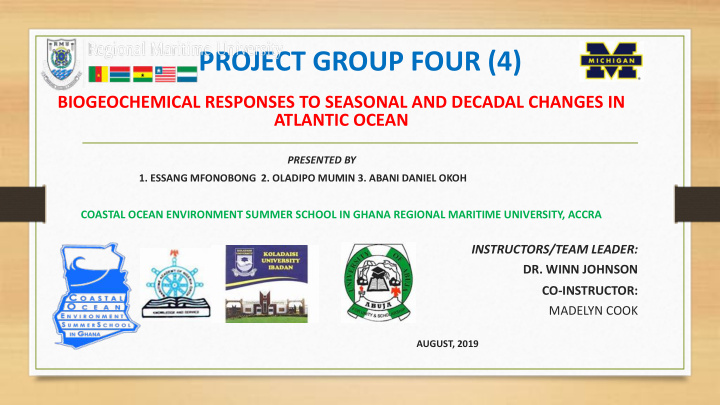



PROJECT GROUP FOUR (4) BIOGEOCHEMICAL RESPONSES TO SEASONAL AND DECADAL CHANGES IN ATLANTIC OCEAN PRESENTED BY 1. ESSANG MFONOBONG 2. OLADIPO MUMIN 3. ABANI DANIEL OKOH COASTAL OCEAN ENVIRONMENT SUMMER SCHOOL IN GHANA REGIONAL MARITIME UNIVERSITY, ACCRA INSTRUCTORS/TEAM LEADER: DR. WINN JOHNSON CO-INSTRUCTOR: MADELYN COOK AUGUST, 2019
Figure 1: SHOWING world map
FIGURE 2: SHOWING ATLANTIC OCEAN • Atlantic Ocean is the 2nd largest • 106,400,000Km2 • Covers about 20% of the earth surface
CO-ORDINATES OF THE DATA POINTS: BERMUDA ATLANTIC TIME-SERIES STUDY (BATS) • Longitude: -64.097 • Latitude: 31.971 • Duration: The data span through 1988 to 2017
AIM AND OBJECTIVES • Aim: • To determine the concentration and seasonal variations in biogeochemical parameter in the coastal waters of Atlantic oceans. • Specific objectives: • To determine variations in temperature, salinity, phosphates, nitrates and nitrites and bacteria abundance in the Atlantic oceans. • To determine the level of dissolved inorganic nutrients in the selected points.
METHODOLOGY AND DATA ANALYSIS • Temperature ( ◦ C), Dissolved oxygen, Electrical Conductivity, and Salinity CTD_S (PSS-78) was measured using Sea-Bird CTD Instrument. • Nutrients were determined using Colorimetric Methods. • Bacterial abundance was counted using DAPI Stain on 0.2 µ m filter. • Python and Ocean Data View (ODV) software were used for the statistical data analysis
PARAMETERS OF INTEREST • Temperature ◦ C • Salinity PSS • Depth m • Time hh mm • Decade year • Dissolved inorganic carbon CO 2 µ mol/kg • TOC µ mol/kg • TN µ mol/kg • PO 4 µ mol/kg • NO 32- µ mol/kg • NO 2- µ mol/kg • Bacterial enumeration cells x 10 8 /kg
HYPOTHESIS Evaporation 1. Temp Salinity Rapid growth 2. Temp Bacterial abundance NULL HYPOTHESIS: ü There is no correlation between seasonal changes in temperature and salinity at p = 0.05 significant level. ü There is no correlation between seasonal changes in temperature and bacterial abundance at p = 0.05 significant level. ü Data were analyzed using Ocean Data View and Python 3.7.0 version tools
Libraries
Data Selection and Reduction
Data Selection and Reduction Cont’
Correlation Matrix
Scatter Plot matrix
Correlation and P-value
FIELD OBSERVATIONS • In this research work our emphasis were on 1. Total Dissolved Phosphorus (TDP) 2. Nitrite 3. Nitrate 4. Bacterial and production 5. Salinity 6. Temperature • Firstly, we look at nutrient variation along Atlantic Ocean with time using Ocean Data View • secondly, based on the data gathered in the ocean both in the surface and deep ocean (i.e Between 0 up to 200 m).
FIG 3: SCHEMATIC SHOWING NITROGEN CYCLE PROCESSES Schematic showing nitrogen cycle processes occurring in the open ocean (left) and the coastal ocean, with an oxygen minimum zone (right). Depth profiles (far left) show typical distributions of light and nutrients (nitrate and phosphate) in the open ocean that can lead to the formation of a deep chlorophyll a maximum (green shading). The processes depicted in the open ocean also occur in the coastal ocean; in the presence of an OMZ, denitrification and anammox lead to nitrogen loss.
PRIMARY PRODUCTION RATES According to the studies carried out by Janet et el., 2012, there is a significant correlation between temperature in open ocean waters and Primary production rates. Figure 4B: Plot of primary production from 2000 – 2017 over a depth transect Fig 4A: Plot of primary production from 1990 – 2017 over a depth transect
PRINCIPAL FACTORS REGULATING BACTERIAL GROWTH AND ABUNDANCES Ø The principal factors regulating bacterial growth and abundances are temperature, substrate supply, predation and mortality due to viruses (Li & Dickie 1987, White et al. 1991, Fuhrman 1992 and Kirchman et al. 1995) Ø Surprisingly, the qualitative and quantitative relationships among these factors are poorly understood as show in this second plot of bacteria. Ø In low to middle latitudes, bacterial activities Fig 5: Plot of Bacterial from 1990 – 2017 over a are normally at a minimum when water depth transect temperatures are low (Findlay et al. 1991, Shiah & Ducklow 1995 etc.
TEMPERATURE AND SALINITY The salinity of the ocean is a function of several factors; one major factor is Temperature. Fig 7: Plot of Salinity from 1990 – 2017 over a depth transect Fig 6: Plot of Temp from 1990 – 2017 over a depth transect
Fig 9: Plot of Nitrate from 1990 – 2017 over a depth transect Fig 8: Plot of TDP from 1990 – 2017 over a depth transect
Fig 10: Plot of Nitrite from 1990 – 2017 over a depth transect Fig 10: Plot of Nitrite from 1990 – 2017 over a depth transect
CONCLUSION AND RECOMMENDATIONS There is significant correlation between temperature and bacterial production rates. Temperature increases with time which confirms effect of global warming in the ocean.
THANK YOU FOR LISTENING
Recommend
More recommend